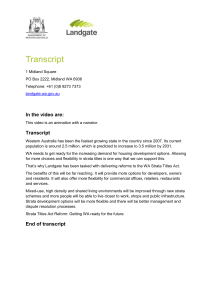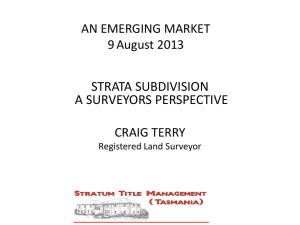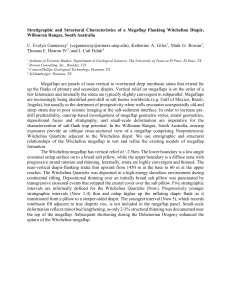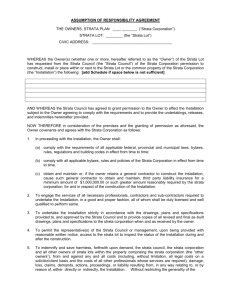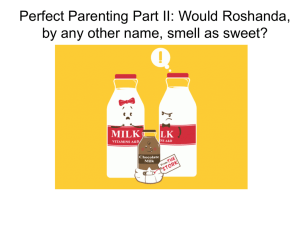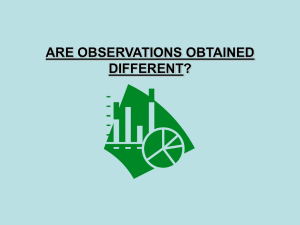Slides - Sigmobile
advertisement
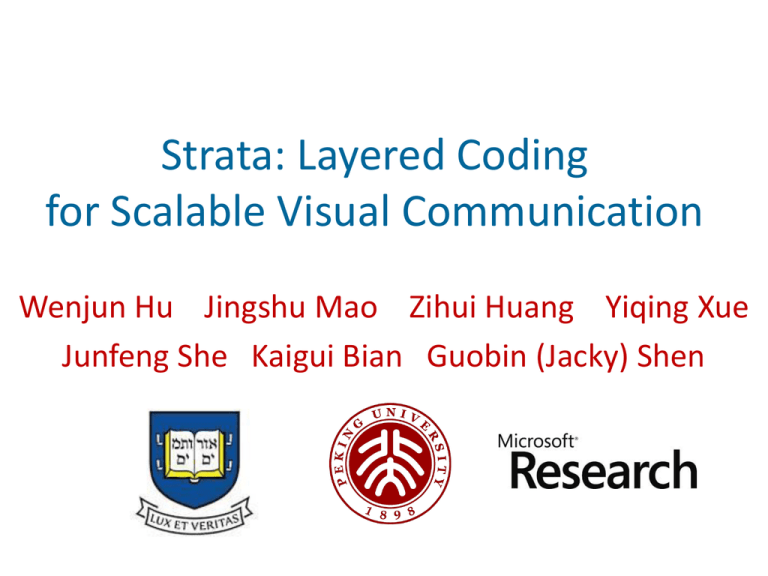
Strata: Layered Coding for Scalable Visual Communication Wenjun Hu Jingshu Mao Zihui Huang Yiqing Xue Junfeng She Kaigui Bian Guobin (Jacky) Shen You may have seen these… Smartphone cameras as “receivers” … everywhere Existing codes: All or nothing Camera view Minimum resolution needed Multi-resolution information display Diverse camera hardware Lumia 1020 ~38MP, 30fps Nexus 5 8MP, 30fps iPhone 4 5MP, 30fps iPhone 5s 8MP, 120fps Capture distance vs resolution Capture resolution < display resolution Undersampling Not supported by existing codes! Our goal • Multi-resolution encoding and decoding – Analogous to HM and SVC for scalable channel/source coding • Decoding performance scales with receiver capability and channel condition In the rest of the talk… • Undersampled channel • Strata design • Strata performance • Focus on spatial, analogous for temporal – See paper for temporal mixing, code design, and performance results UNDERSAMPLED CHANNEL Spatial undersampling Original image Captured at 28m , enlarged Spatial undersampling • In theory, linear mixing of pixel colors a b c d • In practice, messier… – (Auto-)Focus, exposure, contrast – Noise at block edges –… Color mixing experiment Patterns of alternating squares Color mixing results Color mixing results For the same distance, close to linear color mixing Color mixing results Darker when further away White is better preserved Color mixing results Less grayscale difference if minimal contrast STRATA DESIGN Toy example • 2 layers – Black overall – Also small blocks • Small white blocks are interference A simple SNR (like) model • Signal = # of small blocks of the intended color • Noise = # of small blocks of other colors – Both noise and interference • This actually reflects color mixing weights for monochrome codes A simple SNR (like) model • If SNR > 1, the overall block carries at least 1 bit of information – Its color can be determined • Key: Control noise/interference – “Reserve” the color of some blocks Basic design • 2-layer structure, with reserved block Base layer block Enhancement layer block Reserved block Ensures black majority Contiguous to mitigate issues in color mixing Harnessing additional bits • Bits from reserved block shape 2 bits from 4 different positions Example 2-layer code Base layer block Enhancement layer block Recursively adding layers • Divide each enhancement block further • Follow the same rule otherwise Base layer (2nd layer) block Reserved Enhancement layer (In)Dependency between layers: rd block (3 layer) block structural, but not the information encoded Harnessing more bits • Adding smaller (third-layer) blocks in the reserved block Harnessing more bits • Doubles the third-layer capacity • Can further add fourth-layer blocks Choice of parameters • Reserved block size – Efficiency vs accuracy tradeoff – Need ½ when not knowing input statistics • “Branching factor” – Control of granularity – 16 offers a good tradeoff • Details in the paper Decoding Decoding • Divide into blocks – Start with Layer 1 • Determine per-block colors – 11 blacks, 5 whites • Majority gives overall block color (black) Decoding • Continue with finer blocks • Stop if can’t divide further STRATA PERFORMANCE Example Strata image 20cm x 20cm on screen, no error correction Decoder implementation Online Android app & Offline version Multi-level decoded info Strata test display Performance metric • Goal recap: The amount of information decoded scales with capture resolution/rate • Metric: decodable bit/layer count Performance (spatial) Performance (spatial) Better camera resolution or shorter distance More decodable information Strata vs Single-layer code Strata vs Single-layer code Strata vs Single-layer code Strata balances capacity and supported distance Other comparison results • Strata vs frequency domain encoding • Strata vs multi-level grayscales • Strata vs group of codes • Details in the paper Related work • Temporal barcode design (inter-frame) – Unsynchronized 4D Barcodes • Spatial barcode design (per-frame layout) – PixNet, COBRA • Visual tags • Hierarchical coding on LED arrays • Other work on visible light communications – E.g., Visual MIMO Conclusion • Diverse screen/surface-camera channels – Hardware diversity – Capture conditions vary • Strata: Layered coding for scalability – The amount of information decoded scales with diverse channel conditions Thank you! Questions?
